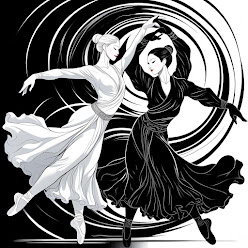Duality and Unity: The Dance of Opposites
I’ve spent most of my life living in contradiction.
I forget why I walked into a room but can recall obscure multiverse metaphors from a podcast I heard once in 2017. I feel everything deeply, but also need three business days to text back. I’ll organize my closet by color and moon phase... and still leave my keys in the fridge.
ADHD, in all its kaleidoscopic chaos, has taught me one thing over and over: we are never just one thing.
We are shadow and sparkle. We are both/and, not either/or. We are contradiction wrapped in consciousness.
And in a world that’s obsessed with categorizing everything as black or white, success or failure, right or wrong, I’ve come to see something else—a deeper, softer truth:
The magic happens not in choosing sides, but in bridging the duality.
Duality and unity are more than just philosophical buzzwords—they’re lenses through which we experience reality, identity, and transformation. Let’s explore what’s known about them from both scientific and spiritual perspectives, and how they relate to reinvention, neurodivergence, and the Gen X journey.
Duality: The Dance of Opposites
At its core, duality is the idea that the world is made up of opposing forces: light and dark, good and bad, mind and body, self and other. It’s how we categorize and make sense of experience. In science, duality shows up in wave-particle duality (where light behaves as both a wave and a particle), and in psychology, it’s reflected in the tension between conscious and unconscious drives.
But duality isn’t inherently negative. It gives us contrast. It helps us define values, boundaries, and desires. The challenge comes when we get stuck in either/or thinking—when we believe we must be one thing or the other, rather than a fluid mix of both.
Unity: The Field Beneath the Form
Unity consciousness, on the other hand, is the idea that all things are interconnected—that beneath the surface of duality, there is only one field of being. This concept is echoed in quantum physics (where entangled particles remain connected across space), in spiritual traditions like Advaita Vedanta and Taoism, and in neuroscience, where practices like meditation have been shown to increase feelings of oneness and empathy.
Unity doesn’t erase difference—it integrates it. It’s not about sameness, but about seeing the whole system. It’s the “yes, and…” to duality’s “either/or.”
The Neurospicy Experience: Living in the In-Between
For those of us with ADHD or other neurodivergent wiring, duality can feel especially intense. We often swing between extremes—hyperfocus and distraction, confidence and shame, connection and overwhelm. But we also feel the unity beneath it all. We sense patterns others miss. We live in the liminal, the layered, the both/and.
That’s not dysfunction. That’s depth perception.
Gen X and the Bridge Between Worlds
As a generation, Gen Xers are uniquely positioned between analog and digital, tradition and disruption, stoicism and self-awareness. We were raised in duality— “be strong, don’t feel”—but we’re waking up to unity. We’re learning to hold space for nuance, to embrace reinvention not as a betrayal of the past, but as a continuation of it.
We’re the bridge generation. And bridges are built to connect.
From Division to Integration: What the Research Says
Recent studies in neuroscience and consciousness research suggest that moving from dualistic to unified thinking can reduce stress, increase empathy, and support mental well-being. Practices like mindfulness, breathwork, and even storytelling help us shift from fragmented identity to an integrated self.
And in quantum theory, the observer effect reminds us: what we focus on becomes real. When we focus on separation, we experience conflict. When we focus on connection, we experience coherence.
Final Thought: You Are the Paradox and the Peace
You are not meant to choose between light and dark, logic and intuition, structure and flow. You are meant to hold them both. To let them inform each other. To let your reinvention be a reconciliation, not of opposites, but of aspects.
You are the duality. You are the unity. You are the bridge.
And that, my friend, is where the real magic lives.






Comments
Post a Comment